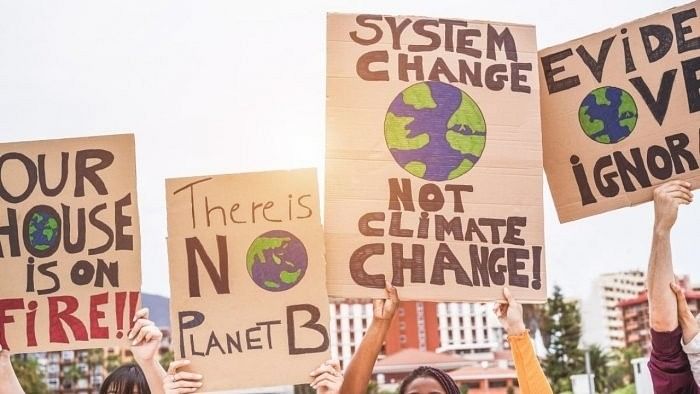
Representative image for climate change protest.
Credit: iStock Photo
Anand Madhukar and Ananya Mohan
Climate change, a looming threat, is no longer confined to the annals of the past. It stands as one of the foremost challenges faced by individuals, communities, nations, and businesses, with its impact set to persist into the foreseeable future. The effects of climate change, witnessed in devastating floods in Libya and Greece, heatwaves in Europe, and landslides in the Himalayas, necessitate a concerted effort to explore and integrate emerging technological tools and innovations into climate solutions and policies.
In this technological landscape, artificial intelligence (AI) emerges as a key player. AI, the capacity of machines to replicate cognitive functions, has permeated diverse sectors such as healthcare, education, infrastructure, automobile, agriculture, and climate. In the climate domain, AI unfolds its potential primarily in two realms: mitigation and adaptation.
Mitigation, the processes and policies targeting the reduction of Greenhouse Gases (GHG) emissions, relies on precise measurement. AI proves invaluable in gauging the net carbon natural stock and carbon footprints of individuals and goods, facilitating the monitoring of changes over time.
In renewable energy, AI contributes by providing forecasts for solar and wind energy. Notably, the national smart grid mission in India currently uses AI to analyse real time data to predict demand, identify inefficiencies and adjust the energy generation. The Nation Grid ESO (UK) also uses AI to increase the accuracy of its forecasts of demand for electricity and thus enabling better integration of renewable energy. AI’s role extends to monitoring carbon sinks like oceans and forest encroachments. The upcoming Carbon capture, utilization, and sequestration (CCUS) technology has immense potential of reducing the emissions through artificial intelligence. AI tools and algorithms can be used to analyse geological data and identify ideal formations where carbon can be stored. Not only this, AI can help ensure the security of underground carbon sequestration through site monitoring.
Adaptation, focussing on building resilience to reduce climate change impact, is another sphere where AI tools excel. Death toll in recent Libya floods could have been reduced had there been a resilient and effective AI enabled early warning system in place. AI aids accurate hazard forecasting, particularly in vulnerable areas like mountains and coastal zones, contributing to disaster impact reduction. Kuzi, a tool developed by a Kenyan company, uses AI to predict locust outbreaks which have intensified due to climate change.
One major way to increase the adaptive capacity of individuals, communities and infrastructure is by managing exposure and vulnerability. AI has found its role in building sustainable and resilient cities which aligns directly with sustainable development goal 11 (SDG 11). Using AI to manage ecosystem restoration and adapt to changing climate can reduce ecosystem pollution and implement effective conservation measures. To improve urban land use and planning, technological tools like remote sensing and geographic information systems can assist the decision makers in making well targeted policies. When we talk about adapting to climate change, it is important to look at how new homes are being built that are resilient in the face of heatwaves, extreme rainfall, and cyclonic events. AI is used to increase the efficiency of heating, ventilation, and air conditioning systems and to incorporate renewable energy systems. AI in buildings also assists in analyzing building data and reducing energy consumption.
Despite these advancements, bottlenecks hinder AI’s full potential. For most nations, AI and climate relevant issues are separated and fall under different ministries, domains - technology and environment respectively. This lack of integration creates an obstacle in wholly incorporating AI into climate. Financial constraints, especially in the global south, and a lack of skill building opportunities further impede AI adoption. Not to forget how our ecosystem is such a dynamic space with so many variables still unknown. This creates an issue of lack of data. However, AI needs data to function and analyse and it cannot give the accurate and desired results with lack of availability of reliable data.
One of the biggest ironies of using AI for climate change is the carbon footprint of AI itself. The MIT Technology Review reports that a single AI model can emit up to 6,26,000 pounds of carbon dioxide equivalent, the same as five average American Cars’ total lifetime carbon dioxide emissions.
Efforts to integrate AI into climate strategies require collaboration between AI experts and governmental policy teams. This collaborative approach enables effective, data-driven policymaking, aligning businesses and countries with science-based targets. Mitigating AI’s carbon footprint involves procuring services from tech firms committed to net-zero targets.
Addressing ethical concerns necessitates the establishment of standards and best practices, coupled with initiatives to enhance AI literacy.
AI as a tool is uniquely positioned to help manage complex issues. However, it cannot do so in isolation. There is a need to incorporate other emerging technologies that can help and assist AI with removing the existing obstacles and filling the gaps.
(Anand Madhukar is Assistant Professor and Programme Coordinator (Climate Science & Policy) and Ananya Mohan is a master’s student at TERI School of Advanced Studies, New Delhi)